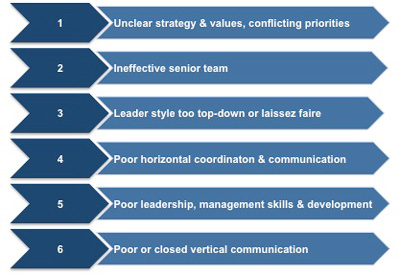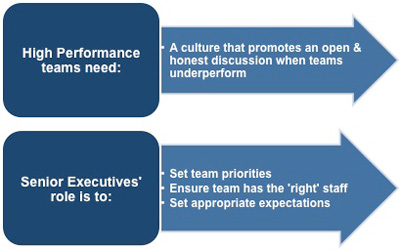Six Silent Barriers to Performance
Mike Beer, a Professor of Business Administration at the Harvard Business School, has identified six 'silent barriers' that cause teams to under-perform .
People working within the organization recognize these barriers, but they cannot be tackled because they result from issues that senior management prefers to ignore.
 |
These silent barriers are:
1. Unclear strategy and values, and conflicting priorities
2. An ineffective senior team
3. Leadership style is too top-down or too laissez faire
4. Poor horizontal coordination and communications
5. Inadequate leadership, management skills and development in the organization
6. Poor or closed vertical communications
Beer says,
'In organizations that exhibit these barriers, you see that the leadership team members are coming with their own agenda, and there is no effective senior team in place that is committed to the same strategy, priorities and values. The lower levels don't know what the top is trying to do and upper levels don't know what they want done. And there is silence; the lower level teams can't speak honestly with the top about what the problems are that block their efficacy-clear and common priorities and strategy or their pattern of management.'
Beer's conclusions are based on the work he and his colleagues have completed with several organizations, using a method called the Strategic Fitness Process, which utilizes organizations' employees as 'researchers.' In their work, Beer and his colleagues ask senior management teams to define their strategic direction in a two or three-page statement and to appoint a task force of 8-10 people who will go out and interview 100 employees across all parts of the organization.
Beer believes that solving the problems that these barriers create is the main issue for many managers. The process of reviewing and setting priorities is a continual one, which with careful monitoring shows when and where adjustments need to be made to ensure teams perform well.
 |
Without these changes coming from the top levels organizations that have cross-functional teams will continue to be ineffective and show poor performance. This is especially true for global corporations where the need to coordinate across different business and geographic regions is essential.
Ultimately, senior management should aim to create a culture that allows constructive discussion on difficult issues without the need to find 'someone to blame.' To achieve this, the executive needs to define priorities, ensure the right employees are assigned to the right teams, and ensure that each team knows what is expected of it.
The findings of these research studies illustrate that some team performance problems may originate from cultural factors that you have no control over. Nonetheless, being aware of these issues should help you to understand why a team may be under-perform ing despite your best efforts.
You may also be interested in:
Team Performance Problems | Herzberg's Hygiene Theory of Motivation | Common Fallacies About Leading Teams | Five Key Team Performance Factors | Matrix Management Issues | Qualities of Leadership | GroupThink and in-group Behavior



